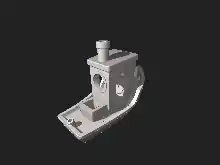 3DBenchy as a downloadable STL file | |
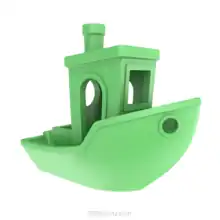 The single-material 3DBenchy model | |
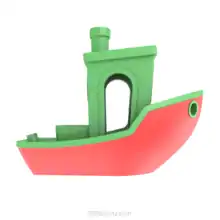 The multi-material 3DBenchy model | |
| Classification | 3D model |
|---|---|
| Used with | 3D printers |
| Inventor | Creative Tools |
The 3DBenchy is a 3D computer model specifically designed for testing the accuracy and capabilities of 3D printers.[1] The 3DBenchy is described by its creator, Creative Tools, as "the jolly 3D printing torture-test" and was released (STL only) in April 2015, with a multi-part, multi-color model released in July 2015.[2][3][4]
Due to its status as a common benchmark, it is believed to be the world's most 3D printed object.[5] The popular 3d-printing website Thingiverse (where the model was originally uploaded) has the 3DBenchy marked as its most popular model of all time.[6] The model itself is a tugboat design, and, as with many 3D prints, actually floats in water given the right conditions in printing.
Gallery
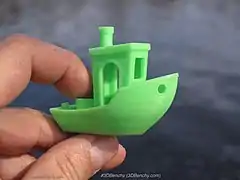 A 3DBenchy printed on a fused deposition modeling (FDM) 3D printer
A 3DBenchy printed on a fused deposition modeling (FDM) 3D printer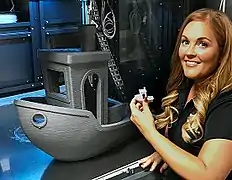 A 10x size (60cm x 31cm x 48cm) 3DBenchy printed in PLA, made on a large-format FDM printer.
A 10x size (60cm x 31cm x 48cm) 3DBenchy printed in PLA, made on a large-format FDM printer.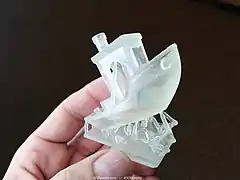 A 3DBenchy printed on a stereolithography (SLA) 3D printer with support material still attached
A 3DBenchy printed on a stereolithography (SLA) 3D printer with support material still attached A multi-material 3DBenchy created on a Prusa i3 using a color-mixing hot end; each part of the boat has been created in a different colour.
A multi-material 3DBenchy created on a Prusa i3 using a color-mixing hot end; each part of the boat has been created in a different colour.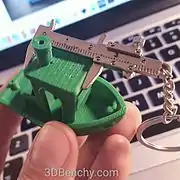 3DBenchy being measured with a caliper-like keyring
3DBenchy being measured with a caliper-like keyring 3DBenchys printed on a FDM 3D printer showing different faults caused by miscalibration
3DBenchys printed on a FDM 3D printer showing different faults caused by miscalibration- Two 3DBenchys being printed on a Hangprinter
See also
References
- ↑ Why the 3D Benchy is the greatest 3D model ever made (and why you might be using it wrong), retrieved 2022-10-28
- ↑ "New dual- & multi-part color version of #3DBenchy test print released". Retrieved 2016-07-29.
- ↑ "Test and calibrate your 3D printer's capacities with the #3DBenchy test project". Retrieved 2016-07-29.
- ↑ "Creative Tools Release #3DBenchy - The Coolest 3D Printer Calibration & Benchmarking Tool Yet". 3DPrint.com. 2015-04-10. Retrieved 2016-07-29.
- ↑ Sarah Anderson Goehrke (November 2017). "#3DBenchy: A Little 3D Printed Boat Making Big Waves as the Most-Printed Object". Retrieved 2020-11-21.
- ↑ Thingiverse.com. "Thingiverse - Digital Designs for Physical Objects". www.thingiverse.com. Retrieved 2023-10-26.
External links
This article is issued from Wikipedia. The text is licensed under Creative Commons - Attribution - Sharealike. Additional terms may apply for the media files.